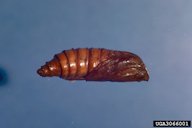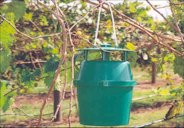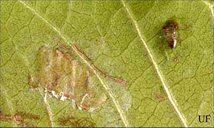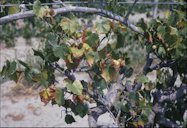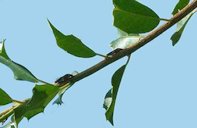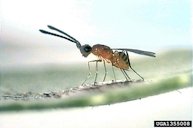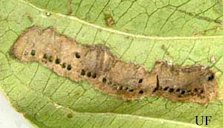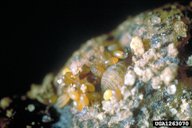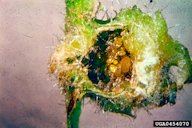| Grape Pests | |||||||||||||||||||||||||||||||||
|---|---|---|---|---|---|---|---|---|---|---|---|---|---|---|---|---|---|---|---|---|---|---|---|---|---|---|---|---|---|---|---|---|---|
| Back
to Muscadine Grape Page Bunch Grape Page 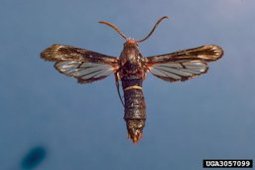 Fig. 1  Grape root borer (female) Vitacea polistiformis 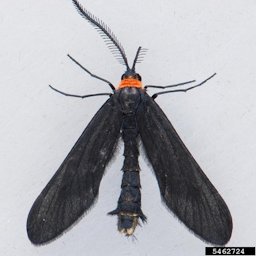 Fig. 6  Adult grapeleaf skeletonizer Harrisina americana (Guérin-Méneville)  Fig. 11  Grape leaffolder Desmia funeralis  Fig. 15  Glassy-Winged Sharpshooter Homalodisca vitripennis 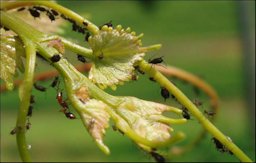 Fig. 23  Grapevine Aphids Aphis illinoisensis  Fig. 24 Grape Curculio Craponius inaequalis 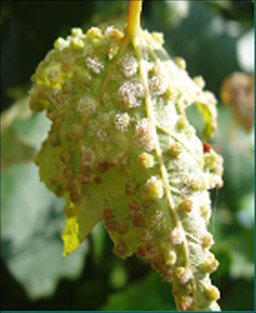 Fig. 26  Grape Aerial Phylloxera Back to Muscadine Grape Page Bunch Grape Page |
Muscadine
grapevines are tolerant of most insect pests, and seldom are
insecticides warranted. Periodically, aphid outbreaks may occur on
shoot terminals, but they seldom persist more than a few weeks due to
the work of natural enemies. Chilli thrips (Scirtothrips dorsalis)
can also cause significant economic damage if not controlled. The grape
root borer (Vitacea
polistiformis)
is thought to be a significant pest of muscadine grapevine and may
contribute to vine mortality, but good data on its economic impact are
lacking. The adult is a moth that resembles a wasp and emerges and lays
its eggs at a time of the year dependent on latitude. The larvae bore
into roots at the base of the trunks and damage vines by consuming root
tissue. An in-row strip maintained weed-free by the use of herbicide is
thought to minimize the density of grape root borers in the root. Also,
a soil insecticide can be used to control this pest. Monitor and watch
for the emergence of the adult insects so that you can time the
application of insecticide. 4 Grape Root Borer Vitacea polistiformis (Harris) The grape root borer (Fig. 1) is the most serious threat to grapes in Florida (Liburd and Seferina 2004). It is a member of the moth family Sesiidae. Adults are brown moths with thin yellow bands on the abdomen and resemble some paper wasps. The front wings are brown while hind wings are transparent. The eggs hatch on the soil surface and the larvae tunnel into the root system. Borer damage causes reduced vine growth, smaller leaves and reduced berry size. Because damage is restricted to below-ground, problems often go unnoticed until the vines start to die. Damage ranges from just a few feeding sites to complete root destruction. Grape root borer presence can be determined by detection of shed pupal skins at the base of the vines. 1
Fig. 2. Grape root borer pupa(e) Fig. 3. Larva(e) and galleries in grape rootstock Fig. 5. Grape root borer trap Further Reading Grape Root Borer, Extension.org pdf Glassy-Winged Sharpshooter (Fig. 15) Homalodisca vitripennis Girault This leafhopper is native to the southeastern United States. The glassy-winged sharpshooter feeds on grapevine stems as opposed to leaves. Females lay eggs in groups of 10-20 on the underside of leaves, just under the surface. The glassy-winged sharpshooter vectors the bacterium Xylella fastidiosa, which causes Pierce's disease in grapes. Pierce's disease is considered the most serious threat to viticulture throughout the United States. It is the single most formidable obstacle to the growing of European-type (vinifera) grapes. Early symptoms of Pierce's disease include wilting, which is caused by bacterial growth that blocks the flow of xylem in affected plants (Brlansky et al. 1983). Subsequent damage includes discolored leaf margins, shrivelled fruit, leaf drop, and irregular maturation of new canes. 1
Fig. 16. Neonate nymph (upper right) and egg mass (left center) of the glassy-winged sharpshooter, H. vitripennis Fig. 18. Adult glassy-winged sharpshooters feeding on holly Fig. 19. Distribution of the glassy-winged sharpshooter in the southeast United States as of 2004 Fig. 20. Distribution of the glassy-winged sharpshooter in California Fig. 21. Gonatocerus triguttatus, a parasititoid wasp lays its eggs in glassy-winged sharpshooter eggs embedded in leaves, two new wasps, G. tuberculifemur and G. metanotalis, have recently been found to attack this sharpshooter's egg Fig. 22. Egg mass of the glassy-winged sharpshooter parasitized by G. triguttatus Further Reading Glassy-Winged Sharpshooter, Homalodisca vitripennis (=coagulata) (Germar), University of Florida pdf Xylella Fastidiosa Diseases and Their Leafhopper Vectors, University of Florida pdf Grapevine Aphid (Fig. 23) Aphis illinoisensis (Shimer) Aphids feed on the young shoots and leaves of grape plants, but more serious injury results from the infestation of the developing fruit clusters. Both the winged and the wingless morphs are found feeding on the succulent part of the plant. Very high population will retard the plant and may also cause the berries to drop. Dry weather contributes to the growth of aphid populations. The grapevine aphid is usually not important enough to necessitate specific treatments. 1 Grape Curculio (Fig. 24) Craponius inaequalis (Say) This curculio has been reported throughout eastern North America. An occasional pest of mature grape berries, the adult grape curculio is a foliage feeder, leaving a characteristic zigzag pattern on the undersurface of grape leaves (McGiffen and Neunzig 1985). It lays eggs in the berry, where larvae feed on the fruit as well as on the seeds. They are distinguished from the caterpillars of the berry moth, another grape berry feeder, by their lack of true legs. Proper orchard sanitation is usually adequate to prevent significant infestations. Pesticide applications are required whenever the insects or damage are present. 1
Grape Phylloxera, vine louse (Fig. 28) Daktulosphaira vitifoliae (Fitch) Grape phylloxera is native to North America and occurs in many wild species of grapes in Florida as well as other areas of the southeastern United States. Bunch grapes (‘Blanc DuBois’, and ‘Conquistador’) varieties were observed to be more susceptible as compared to four muscadine varieties (‘Carlos bronze’, ‘Noble black’, ‘Triumph Bronze’, and ‘Alachua black’). The presence of grape phylloxera is easily recognized due to the characteristic galls that develop on the leaves. Leaf (aerial) phylloxera does little harm and does not necessarily take up residence in all Florida vineyards. These galls also occur on the roots but they are not readily apparent. Root galls are small knots (enlarged areas) on the roots, which interfere with the roots' ability to absorb water and mineral salts (Flaherty et al. 1992). An aphid-like insect is responsible for causing the symptoms of grape phylloxera. Many native American grapes are tolerant or resistant to root attack and are used as rootstocks for European grapes in other parts of the country. 1
Fig. 27. Adults, juveniles and eggs Fig. 28. Cross section of grapevine leaf gall caused by Viteus vitifoliae Fig. 29. Grapevine phylloxera, root galls Fig. 30. Life cycle |
||||||||||||||||||||||||||||||||
| Bibliography 1 Liburd, Oscar, et al. "Insects Pest of Grapes in Florida". Entomology and Nematology Dept., UF/IFAS Extension, ENY-713, Original Pub. Feb. 2004, Revised June 2013, AskIFAS, edis.ifas.ufl.edu. Archived. Accessed 17 Nov. 2014. 2 Mead, F.W. and Webb, Susan E. "Grape Leaffolder, Desmia funeralis (Hubner) (Insecta: Lepidoptera: Crambidae)." EENY-192, Entomology and Nematology Dept., UF/IFAS Extension, Original Pub. Feb. 2001, Revised Aug. 2014 and Feb. 2022, AskIFAS, edis.ifas.ufl.edu/IN349.pdf. Accessed 27 Nov. 2014, 8 June 2022. 3 Mead, F. W., and Susan E. Webb. "Grapeleaf Skeletonizer, Harrisina americana (Guerin-Meneville) (Insecta: Lepidoptera: Zygaenidae)." Dept., of Entomology and Nematology, UF/IFAS Extension, EENY-191, Original Pub. Feb. 2001, Reviewed July 2020, AskIFAS, edis.ifas.ufl.edu/IN348.pdf. Accessed 27 Nov. 2014, 8 June 2022. 4 Andersen, Peter C., et al. "The Muscadine Grape (Vitis rotundifolia Michx)." Horticultural Sciences Dept., UF/IFAS Extension, Original Pub. June 2003, Revised Nov. 2010, Oct. 2013, Jan. 2017, and Oct. 2020, AskIFAS, edis.ifas.ufl.edu/publication/HS100. Accessed 17 Sept. 2018, 28 Sept. 2020. Photographs Fig. 1,3,4 Solomon, James. "Grape root borer." USDA Forest Service, 1999, Bugwood.org, (CC BY 3.0 US), bugwood.org. Accessed 17 Nov. 2014. Fig. 2 "Grape root borer."Clemson University, USDA Cooperative Extension Slide Series, 2002, Bugwood.org, (CC BY 3.0 US), bugwood.org. Accessed 17 Nov. 2014. Fig. 5 Weihman, Scott. "Grape root borer trap." University of Florida, AskIFAS, edis.ifas.ufl.edu. Accessed 17 Nov. 2014. Fig. 6 Dreiling, Mark. "Grape Leaf Skeletonizer (Harrisina americana) (Guerin-Meneviille)." Bugwood.org, (CC BY 3.0 US), bugwood.org. Accessed 17 Nov. 2014. Fig. 7,8 Adlerz, Warren. "Larvae of the grapeleaf skeletonizer, Harrisina americana (Guérin-Méneville), feeding on a grape leaf." University of Florida, AskIFAS, edis.ifas.ufl.edu. Accessed 27 Nov. 2014. Fig. 9 "Underside of 'Lake Emerald' grape leaf, showing considerable damage by young larvae of the grapeleaf skeletonizer." Division of Plant Industry, University of Florida, AskIFAS, edis.ifas.ufl.edu. Accessed 27 Nov. 2014. Fig. 10 "Partial skeletonization of 'Lake Emerald' grape leaf by larvae of the grapeleaf skeletonizer." Division of Plant Industry, University of Florida, AskIFAS, edis.ifas.ufl.edu. Accessed 27 Nov. 2014. Fig. 11 Dreiling, Mark. "Grape Leaffolder (Desmia funeralis) Adult." Bugwood.org, 2012, (CC BY 3.0 US), bugwood.org. Accessed 27 Nov. 2014. Fig. 12 "Grape Leaffolder larvae." University of Florida, AskIFAS, edis.ifas.ufl.edu. Accessed 27 Nov. 2014. Fig. 13 Adlerz, Warren. "Damage to bunch grape foliage caused by the grape leaffolder." University of Florida, AskIFAS, edis.ifas.ufl.edu. Accessed 27 Nov. 2014. Fig. 14 Jensen, F. L. "Damage to muscadine grape leaf with characteristic roll caused by the grape leaffolder, Desmia funeralis (Hübner), also showing silk strands." Farm Advisor, California, University of Florida, AskIFAS, edis.ifas.ufl.edu. Accessed 27 Nov. 2014. Fig. 15 Conklin, Tracy. "Glassy-winged sharpshooter (Homalodisca vitripennis) (Germar, 1821)." Pest and Diseases Image Library, 2013, Bugwood.org, (CC BY 3.0 US), bugwood.org. Accessed 8 Aug. 2016. Fig. 16 "Neonate nymph (upper right) and egg mass (left center) of the glassy-winged sharpshooter, Homalodisca vitripennis (Germar)." University of Florida, AskIFAS, edis.ifas.ufl.edu Accessed 8 Aug. 2016. Fig. 17 Hopkins, Don. "Pierce's disease on grape leaf" University of Florida, Apopka, AskIFAS, edis.ifas.ufl.edu. Accessed 27 Nov. 2014. Fig. 18 Conklin, Tracy. "Adult glassy-winged sharpshooters, Homalodisca vitripennis (Germar), feeding on holly." University of Florida, AskIFAS, edis.ifas.ufl.edu. Accessed 8 Aug. 2016. Fig. 19 "Distribution of the glassy-winged sharpshooter, Homalodisca vitripennis (Germar), in the southeast United States as of 2004." University of Florida, AskIFAS, edis.ifas.ufl.edu. Accessed 8 Aug. 2016. Fig. 20 "Distribution of the glassy-winged sharpshooter, Homalodisca vitripennis (Germar), in California." California department of Food and Agriculture, 2006, cdfa.ca.gov. Accessed 6 Aug. 2016. Fig. 21 Garcia III, Reyes. "Gonatocerus triguttatus, a wasp parasititoid wasp lays its eggs in glassy-winged sharpshooter eggs embedded in leaves." USDA Agricultural Research Service, Bugwood.org, (CC BY 3.0 US), bugwood.org. Accessed 6 Aug. 2016. Fig. 22 Conklin, Tracy. "Egg mass of the glassy-winged sharpshooter, Homalodisca vitripennis (Germar), parasitized by Gonatocerus triguttatus Girault." University of Florida, AskIFAS, edis.ifas.ufl.edu. Accessed 6 Aug. 2016. Fig. 23 Weihman, Scott. "Grapevine aphids." University of Florida, AskIFAS, edis.ifas.ufl.edu. Accessed 27 Nov. 2014. Fig. 24,25 Wright, Natasha. "Grape curculio." Cook's Pest Control, 2007, Bugwood.org, (CC BY 3.0 US), bugwood.org. Accessed 10 Aug. 2016. Fig. 26 Weihman, Scott. "Grape aerial phylloxera." University of Florida, AskIFAS, edis.ifas.ufl.edu. Accessed 28 Nov. 2014. Fig. 27 "Grapevine phylloxera, vine louse." Central Science Laboratory, Harpenden Archive, British Crown,2007, Bugwood.org, (CC BY 3.0 US), bugwood.org. Accessed 28 Nov. 2014. Fig. 28 "Cross section of grapevine leaf gall caused by Viteus vitifoliae." Biologische Bundesanstalt für Land- und Forstwirtschaft Archive, Biologische Bundesanstalt für Land- und Forstwirtschaft, Bugwood.org, (CC BY 3.0 US), bugwood.org. Accessed 28 Nov. 2014. Fig. 29 "Grapevine phylloxera, vine louse, root galls." Central Science Laboratory, Harpenden Archive, British Crown, 2004, Bugwood.org, (CC BY 3.0 US), bugwood.org. Accessed 28 Nov. 2014. Fig. 30 "Life Cycle." Ohio State University, oardc.ohio-state.edu. Accessed 28 Nov. 2014. Published 12 Apr. 2014 LR. Last Update 8 June 2023 LR |
|||||||||||||||||||||||||||||||||

